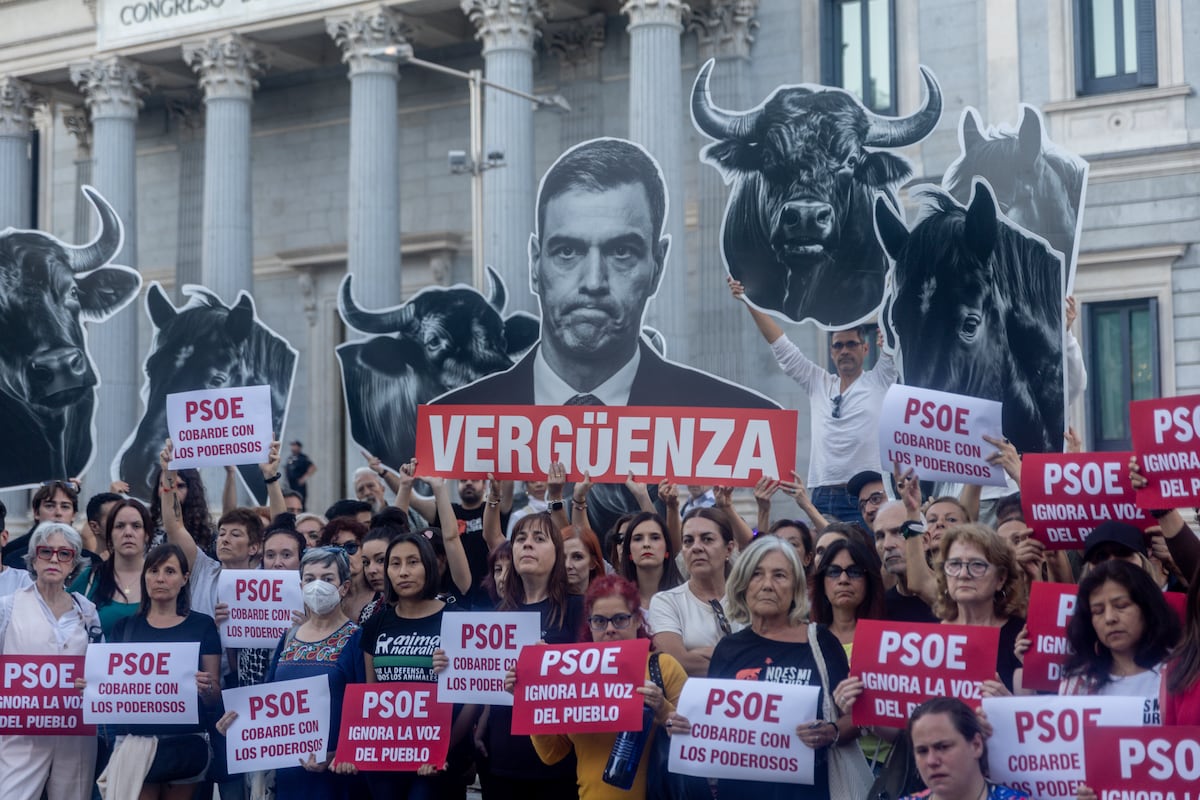The congressional debate wasn’t even held. But almost two weeks later, it’s still being talked about. On October 7, Spain’s Congress of Deputies refused to consider a Popular Legislative Initiative (ILP in its Spanish acronym) — a procedure that lets citizens propose legislation to Congress and which requires at least 500,000 signatures — to withdraw national cultural protection from bullfighting. In other words, the lawmakers chose to dismiss the issue without giving it a chance for parliamentary debate, in a vote marked by the conspicuous abstention of the main party in government, the center-left Socialist Party (PSOE). In the process, they turned a deaf ear to 664,777 citizens, as many as the signatures supporting the proposal. In the seat of Spanish democracy, the conversation about bullfighting was vetoed. But not even parliament can prevent it from continuing in the streets.
The move has brought joy to the political right and to the bullfighting industry, which has emerged stronger from a critical crossroads. “We’ve gone from being banned by almost everyone, to moving forward with even more enthusiasm,” said Sabino Gutiérrez Bañares, former president of the Cocherito bullfighting club in Bilbao, the largest in Spain. “Who are they to decide what is culture and what isn’t? Animal rights activists want to cancel everything they don’t like,” adds Antonio Bañuelos, president of the Royal Union of Bullfighting Breeders.
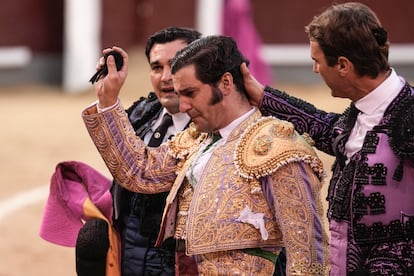 Morante de la Puebla, at the Autumn Fair bullfight held in the Las Ventas bullring, where he retired.Borja Sánchez-Trillo (EFE)
Morante de la Puebla, at the Autumn Fair bullfight held in the Las Ventas bullring, where he retired.Borja Sánchez-Trillo (EFE)
Their relief is in contrast with the indignation of the committee that worked to bring the ILP to Congress, only to see months of effort snubbed in one afternoon. This group has denounced the “betrayal” of the Socialists; meanwhile, the government’s minority partner, the leftist Sumar, has promised not to “forgive” what happened and to revive the initiative. Even Prime Minister Pedro Sánchez, a Socialist, was forced to make a statement: he acknowledged in an interview last week that bullfighting “is not a resolved issue within the PSOE.” He explained it this way: “There are activists who are in favor, and others who are against, just like Spanish society.”
In reality, the statement only confirmed what was already evident. Also, that the issue is a complex and tangled one. Bullfighting was depicted by Goya and written about by Federico García Lorca. Where some see cruelty, shame and bloated subsidies, others see epic, identity pride, and resistance. On Sunday, October 12, a few days after the ILP failure in Congress, the bullfighter José Antonio Morante de la Puebla dedicated his retirement to Santiago Abascal, leader of the extremist Vox party: “Here’s to everything you do for us. Long live Spain!”
A majority rejects bullfighting
The animal rights movement is gaining strength: 77% of the Spanish population rejects bullfighting, according to a report published in February by the BBVA Foundation. On October 7 it lost, however, to another growing movement within the country: the alleged defense of the Spanish soul.
Juan Antonio Carrillo Donaire, a professor of administrative law at the University of Seville and bullfight aficionado, ventures into less-explored territory: the one that lies between the two trenches. “The worst thing that has happened to the fiesta is this shift toward opposing political positions. Within the bullfighting world itself, there is a pernicious approach. Their protection strategy is flawed: I don’t believe bullfighting is part of our national heritage, but rather a specific cultural manifestation rooted in certain Spanish territories. A person from [the northern regions of] Cantabria or Galicia will not identify with it, and they may even experience it as an attack [on their own identity].”
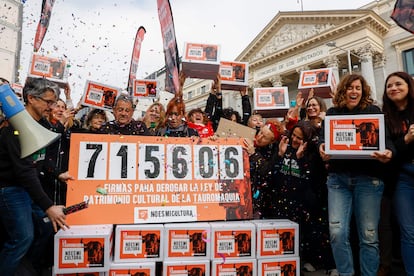 Members of the committee promoting the ILP “It’s Not My Culture” before the Congress of Deputies last February.J.J. Guillén Efe
Members of the committee promoting the ILP “It’s Not My Culture” before the Congress of Deputies last February.J.J. Guillén Efe
A survey published on October 8 by the Ministry of Culture provides figures to support this argument. Attendance at least once a year at events involving bulls remains at a mere 8% — and only 5.9% at actual bullfights — the same as it was before the Covid pandemic. However, this figure rises to 30% in the regions of Navarre and La Rioja. The age groups with the highest attendance figures are the 45-to-64 bracket, and most especially the 15-to-24 group. Despite the UN Committee on the Rights of the Child recommending that Spain prohibit attendance by under-18s, admission is still permitted for anyone aged 14 and older.
Bullfighting is the cultural activity that generates the most opposition: 68% of Spaniards say their interest in it lies between 0 and 2 (on a scale of 10), a percentage that exceeds 80% in the regions of Catalonia, Galicia and the Canary Islands. At the other end of the spectrum, 6.4% of the population is greatly interested in bullfighting, with the highest interest found in the regions of Castilla-La Mancha, Castilla y León, and Extremadura. In 2023 there were 1,474 bullfights in Spain, more than before the pandemic. The overwhelming majority, however, were concentrated in Madrid, Castilla-La Mancha, Castilla y León and Andalusia. “It’s a minority activity, but it exists. And where it does have roots, it’s not such a minority activity either,” notes Gutiérrez Bañares. This is why the PSOE’s recent abstention in Congress also has a political reading: fear of the cost that an affirmative vote on debating the ILP might have had in the 2026 Andalusian regional elections.
The law of 2013
Twelve years ago, a conservative government led by the Popular Party (PP) decided to protect bullfighting at the national level — with another notable abstention from the PSOE — through Law 18/2013, which is still in force. This law establishes that bullfighting “forms part of the cultural heritage worthy of protection throughout the national territory.” It also states that “the public authorities shall guarantee its conservation and promote its enrichment.” The recently rejected ILP sought to repeal this legislation on two fronts: to end animal abuse, and to return power of decision to the regional governments. The idea was for each regional authority to be able to decide whether to prohibit, maintain, or promote bullfighting. “I think this will be the final destination in the long run,” adds Carrillo Donaire.
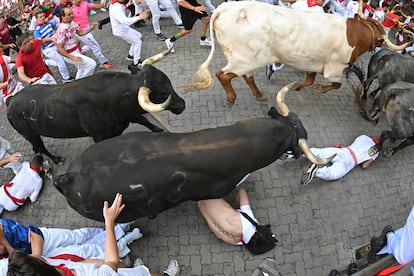 The 2025 Running of the Bulls in Pamplona, Navarre.Daniel Fernández (EFE)
The 2025 Running of the Bulls in Pamplona, Navarre.Daniel Fernández (EFE)
Aïda Gascón, a member of the ILP’s committee, promises to keep up the fight. They have meetings scheduled with Sumar and other parties that supported them to discuss the next steps. “The first few days were tough. We felt disappointed and betrayed by the PSOE. And by the way politics works: many ILPs never even make it to the debate stage, not even one as strongly supported as ours. It’s an insult to the public. Furthermore, by law, the costs of the process are compensated with up to €300,000 ($348,000), which is what it will cost Congress and everyone, without it even being processed,” she laments.
Of the 154 ILPs presented since 1984, only two were endorsed by Congress, with modifications, and another two were incorporated into other laws. Ironically, the 2013 law protecting bullfighting was driven by another popular initiative, launched by the Federation of Bullfighting Entities of Catalonia in 2012.
Two years earlier, Catalonia had abolished bullfighting within its territory. The measure, however, was overturned by the Constitutional Court in 2016, because in the meantime the PP government had passed the law granting national protection to bullfighting. And the highest court also shot down a move by the Balearic Islands in 2017 to avoid the death of the animal in the bullring: the central characteristics of a state-protected activity could not be changed.
That was the beginning of the popular movement to repeal the 2013 national law, an effort that has foundered at its first parliamentary hurdle, despite garnering the support of the entire political left, as well as Basque, Catalan and Galician nationalists. The initiative had been openly rejected by the PP, Vox, and by the Navarrese People’s Union, in this latter case motivated by the San Fermín running of the bulls festival. “We consider it censorship; bullfighting has no ideology. More than 60% of municipalities, of all political stripes, hold fiestas with bulls,” declared María Soledad Cruz Guzmán García, the PP spokesperson against the ILP, before the vote that rejected further consideration.
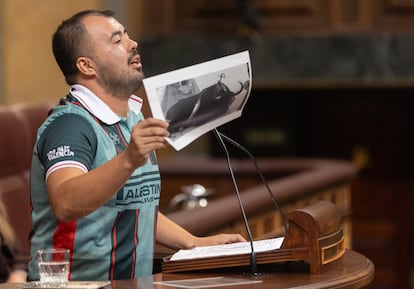 Nahuel González, a lawmaker for Sumar, shows a photograph of a bull at a fight as he speaks in Congress. Eduardo Parra (Europa Press)
Nahuel González, a lawmaker for Sumar, shows a photograph of a bull at a fight as he speaks in Congress. Eduardo Parra (Europa Press)
The philosopher José Ortega y Gasset maintained that it was “impossible to understand” the history of Spain without knowing the history of bullfighting. It’s difficult to say whether that phrase still holds true. The truth is, it represents an anomaly: France, where there is a lot of bullfighting in the south of the country, and Portugal, where bulls are not killed in most places, are the only two other countries in Europe that allow bullfights. Across the ocean, there are also Mexico and Peru, while Colombia has just banned them. None, however, experience them quite like Spain does. “In France, you see communist mayors going to the bullfights,” notes Carrillo Donaire. “There’s no politicization because the starting point is different; bullfighting is protected from the point of view of minority rights, in the face of an opposing majority sentiment. It’s clear that these days, the dominant culture favors animal rights. But, for someone raised in that world, abolishing it means attacking their beliefs.”
“The fighting bull has a natural fighting instinct that often makes its behavior unpredictable. Handling it in the field requires great preparation and knowledge. It is a unique native breed, the breed of breeds, and if there were no bullfighting events, it would disappear,” notes Bañuelos, of the Royal Union of Breeders of Fighting Bulls.
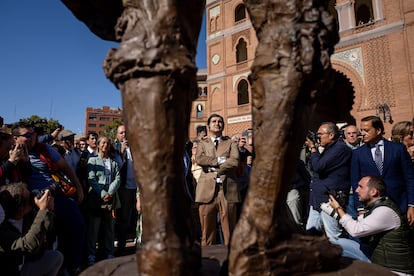 Morante de la Puebla, in the center, on October 11 at the inauguration of the statue of Antoñete in front of the main gate of Las Ventas.Daniel González (EFE)
Morante de la Puebla, in the center, on October 11 at the inauguration of the statue of Antoñete in front of the main gate of Las Ventas.Daniel González (EFE)
The organization that Bañuelos chairs has 342 affiliated companies. It estimates 61,800 breeding cows in Spain and a total census of the fighting breed at 148,013 animals. “The more than 900 bullfighting ranches spread across Spain, France, and Portugal occupy more than 500,000 hectares and generate more than 14,000 direct jobs in the so-called Emptied Spain,” says Bañuelos. Even Sumar’s dream of a country without bullfighting includes a transition plan to guarantee jobs for these families. “The production costs of a fighting bull range between approximately €5,000 and €6,000. The profit, when there is any, is very low. We are here because of the passion and love we have for fighting bulls.”
In any case, Sabino González, of the Bilbao club, expresses doubts about the more showy political confrontations: “I get the feeling there’s quite a bit of inconsistency and a certain amount of grandstanding. In small towns with a tradition of it, bull-centered fiestas continue to take place, and some of these places are run by [the far-left] Bildu.” Pamplona, which also has a Bildu mayor, has an undeniable attachment to bullfighting, as the San Fermín festival demonstrates each year. Today, the right has forged an alliance with the world of bullfighting through public support and subsidies. But four decades ago, this world fascinated the Movida movement, with its countercultural and progressive spirit.
Certain views, however, seem irreconcilable. “It’s a blatant, cruel form of animal abuse, completely unacceptable in most countries around the world,” says Aïda Gascón. “Abuse is taking an animal out of its natural habitat and cramming it into an apartment just a few square meters in size,” retorts Bañuelos.
Gutiérrez Bañares admits that there are areas that could be improved: causing fewer injuries to the animal during the fight; not prolonging its final minutes unnecessarily. The debate over bullfighting seems destined to last for a long time to come. And that, in some way, also speaks about Spain.
Sign up for our weekly newsletter to get more English-language news coverage from EL PAÍS USA Edition
